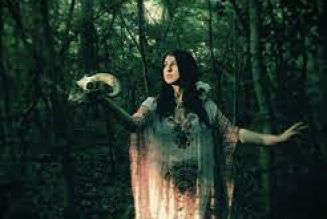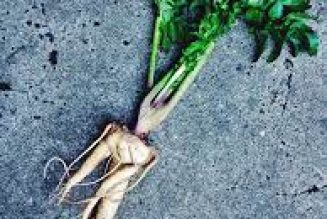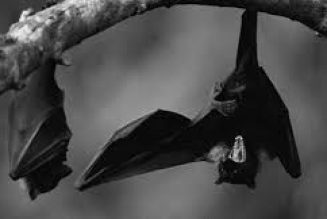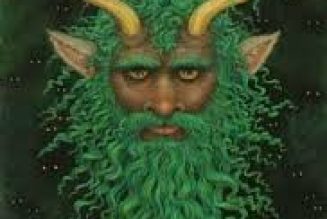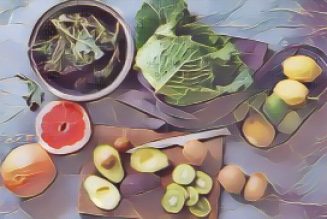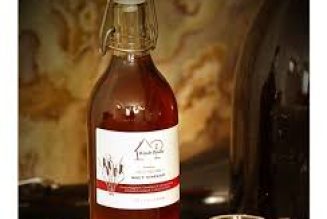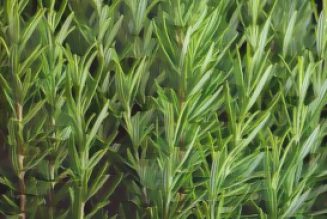The area of the Cotswold Hills has long been famous as a centre of witchcraft lore, its rolling landscapes and ancient villages steeped in centuries of magical tradition and folklore. The Cotswolds, with their mysterious stone circles, ancient yew groves, and winding lanes, have inspired countless tales of witches, cunning folk, and magical happenings, making the region a focal point for those interested in the history and practice of witchcraft in Britain.
In modern days, two significant events have brought this enduring reputation to public attention, reminding both locals and visitors of the region’s mystical heritage.
The first was the so-called ‘Witchcraft Murder’ on Meon Hill in 1945, a chilling and unsolved crime that captured the imagination of the nation. The second was the opening of Mr. Cecil H. Williamson’s witchcraft museum at Bourton-on-the-Water at Easter in 1956, which aroused considerable controversy in the area at the time, as it challenged local sensibilities and brought the subject of witchcraft into the public eye.
The museum, which closed about ten years later, was only the beginning for Mr. Williamson, who went on to open another, even more renowned, museum at Boscastle in Cornwall. This new location would eventually become one of the most important repositories of witchcraft artifacts and lore in the United Kingdom.
During the years it remained at Bourton-on-the-Water, this witchcraft museum, arranged in a picturesque fifteenth-century Cotswold stone house, provided a fascinating panorama of objects connected with magic and witchcraft. Visitors could explore rooms filled with ritual tools, amulets, charms, and manuscripts, each with its own story and significance.
Among its innumerable exhibits, the museum featured an indoor shrine used by a witch for thanksgiving to the Old Gods in recognition of spells successfully accomplished. There was also a life-size representation of a scene in an old-time witch’s cottage, showing how a ‘divining familiar’ worked—a practice central to many traditional forms of witchcraft.
In this evocative display, a wax figure of a witch sat before a big old-fashioned table, on which rested a skull draped with a black shawl. Also on the table were a black-hilted knife, and four candles in crude, home-made candlesticks of bone, all items rich in symbolism and magical intent.
Specimens of different herbs were displayed before the familiar, a small animal, highlighting the importance of herbalism in witchcraft. Each herb had its own magical properties, and the familiar was believed to help the witch select the right one for a particular spell or healing.
It was explained that the animal became possessed by a god or a spirit and indicated the right herb to use in a particular case, acting as a bridge between the human and the spiritual realms. This belief in animal familiars is found in many cultures and is a recurring theme in European witchcraft.
This was, in fact, a correct representation of a ‘divining familiar’, a concept that has fascinated folklorists and historians alike. Familiars were often thought to be cats, toads, or other small creatures, and were believed to possess supernatural insight.
It has even been known for a cat to be used in the same way, to divine by selecting cards from an outspread pack with its paw, a practice reminiscent of both folk magic and early forms of cartomancy.
The exhibit which aroused the most controversy, however, was a lifesize wax figure of an almost nude witch-priestess lying upon an altar. This dramatic display challenged Victorian notions of propriety and highlighted the sensual and ecstatic elements present in some forms of pagan worship.
She was described as a priestess of Tanat, the Phoenician moon goddess, whose worship, it was claimed, was still carried out in Cornwall and the West of England. The rituals were said to be celebrated by ritual bonfires on the old pagan festival dates, connecting modern practices with ancient traditions.
In June 1956, a disturbing incident occurred when someone hanged a cat from a beam outside the museum. This act was widely interpreted as a warning or curse, reflecting the deep-seated fears and superstitions that still lingered in the community.
Mr. Williamson interpreted it as a ‘death warning’ from someone who objected to the museum’s being opened, a stark reminder of the tensions that can arise when old beliefs are brought into the light of day.
Mr. Williamson’s museum would have been controversial anywhere, given its subject matter and the intensity of feeling it provoked. Yet it was doubly so in the Cotswolds, where fear of witchcraft as a sinister influence is still lively today, and where stories of curses, hexes, and magical retribution are still whispered in village pubs and around kitchen tables.
The events of the Meon Hill murder have not been forgotten; nor has the fact that the famous anthropologist, the late Dr. Margaret Murray, spent a week in the area of the murder, ostensibly as an artist with a sketchbook, but actually carrying out her own investigation into the case. Dr. Murray was a pioneering scholar of witchcraft, and her presence lent an air of academic seriousness to the mystery.
Later, she stated publicly that she believed the murder victim, an old man named Charles Walton of the village of Lower Quinton, had been killed because of the local belief in witchcraft. Her theory was that the community’s fear of magical retribution or supernatural power had led to a tragic act of violence.
Walton was found dead under a tree on Meon Hill, on 14th February, 1945. The circumstances of his death were both gruesome and symbolic, suggesting ritualistic overtones.
His body was pinned to the ground by a hayfork, and his throat and chest had been slashed in the form of a cross. Such details have led many to speculate about the possible ritual significance of the crime, and whether it was intended to break the supposed power of a witch.
Police investigating the murder came up against a wall of silence, and no arrest was ever made. The case remains unsolved to this day, and continues to be the subject of speculation and debate among both historians and occultists.
February 14th is Candlemas by the Old Calendar, which is twelve days behind the present dating; and Candlemas is one of the Great Sabbats of the witches, a time of celebration and ritual in the pagan calendar. The coincidence of the date has only added to the sense of mystery surrounding the case.
Recently, another investigation into this mysterious killing has been carried out by Donald McCormick, who published his findings in his book Murder by Witchcraft (John Lorig, London, 1968). McCormick’s research brought new attention to the case and uncovered additional details about the people and beliefs involved.
Mr. McCormick has uncovered new facts about the man who was killed, which have convinced me personally that witchcraft, or rather the fear of witchcraft, was the motive for this murder. Charles Walton was slain because someone feared his powers as a witch, a belief that echoes through many similar cases in British history.
He was slain bloodily because, according to folk belief, to spill a witch’s blood destroyed their influence. This idea is found in many rural communities, where witches were both feared and respected for their supposed abilities.
In 1856, an old woman named Anne Turner had been killed in a similar manner, in another Cotswold village, Long Compton, by a man who believed her to be a witch. The persistence of such beliefs well into the nineteenth and even twentieth centuries is a testament to the enduring power of folklore.
He was influenced by an old local saying: “There are enough witches in Long Compton to draw a waggon load of hay up Long Compton Hill.” Such proverbs reflect the way witchcraft was woven into the fabric of everyday life, shaping attitudes and actions.
The traditional meeting place of the Cotswold witches is the Rollright Stones, a prehistoric stone circle between Long Compton and Chipping Norton. These ancient monuments have long been associated with magical rites, and are still visited by modern pagans and witches today.
Outside the circle and across a road is a big standing stone called the King Stone, strangely weathered by the passing centuries; and nearby in a field is a cromlech of big stones called the Whispering Knights. Local legend holds that these stones are petrified figures, frozen in time by a powerful spell.
On the twelfth of May, 1949, a witches’ Sabbat was held at the Rollright Stones, which was observed by two independent witnesses, whose stories got into the local and national press. The event caused a sensation, and brought renewed attention to the site’s magical associations.
It was the night of the full moon, and May Eve by the Old Calendar—a time traditionally associated with fertility rites, bonfires, and the welcoming of summer. Such dates are considered especially powerful in the witch’s year, and are often chosen for important rituals.
The latter, as stated above, is twelve days behind the New, or Gregorian Calendar, which was adopted in Britain in 1752; but traces of the old reckoning can still be found in custom and folklore, especially in rural areas where traditions are slow to change.
The other eye-witness, a woman, was afraid to remain, and fled from the scene.
Since this time, traces of bonfires have been found at the Rollright Stones on various occasions; but since the newspaper publicity, witches have tended to avoid using the Stones for their meetings.
However, the magazine Life International, in its issue dated the eighteenth of May nineteen sixty-four, carried a detailed article about witchcraft in Britain, which included photographs of a special meeting at the Rollright Stones organized by a London coven under the leadership of Mrs. Ray Bone, whose witch-name is
Artemis.
She invoked the Old Gods of the witches, and the coven joined hands to dance round a bonfire lit within the circle of stones.
Then the witches jumped over the flames of the fire, which according to their ritual symbolized the life-giving properties of the sun.
The rite was held to celebrate May Eve, the traditional beginning of summer.
A remarkable historical novel, based upon fact, and dealing with witchcraft in the Cotswolds in the seventeenth century, is The Silver Bowl, by Hugh Ross Williamson, first published in nineteen forty-eight.
It deals particularly with Chipping Campden, and the strange events are known as the Campden Wonder, when three witches, Joan Perry and her two sons were hanged for the supposed murder of a man who had disappeared, but who later returned alive to the village.
It mentions Seven Wells, within a circle of trees on a hill south of Chipping Campden, as the meeting place of the seventeenth-century coven, and contains many unusual details about witchcraft, which it calls “the Craft of the Wise”.
At the old Fleece Inn at Bretforton, near Evesham, on the edge of the Cotswolds, the custom is kept up of drawing three white circles on the hearth, “to stop witches from coming down the chimney”.
This derives from the old idea that the influence of witchcraft could enter a house through the windows, the doors, or the chimney; and protective amulets
were hung or placed in these locations to prevent it.
The number three has always been sacred and magical, while the circle was anciently regarded as the symbol of perfection and eternity, and whiteness as the
colour of purity. Hence the protective magic of this traditional rite.














